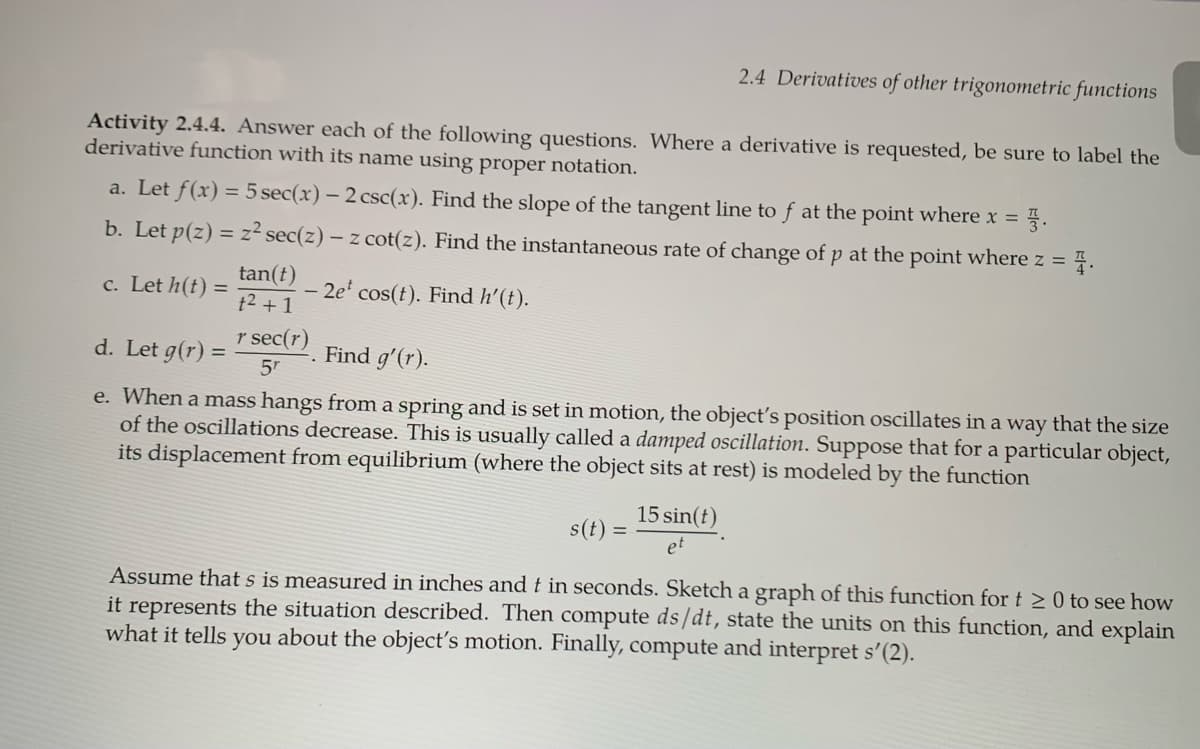Calculus: Early Transcendentals
8th Edition
ISBN:9781285741550
Author:James Stewart
Publisher:James Stewart
Chapter1: Functions And Models
Section: Chapter Questions
Problem 1RCC: (a) What is a function? What are its domain and range? (b) What is the graph of a function? (c) How...
Related questions
Question
Can you help me with D and E

Transcribed Image Text:2.4 Derivatives of other trigonometric functions
Activity 2.4.4. Answer each of the following questions. Where a derivative is requested, be sure to label the
derivative function with its name using proper notation.
a. Let f(x) = 5 sec(x) – 2 csc(x). Find the slope of the tangent line to f at the point where x =
b. Let p(z) = z² sec(z) – z cot(z). Find the instantaneous rate of change of p at the point where z =
1.
tan(t)
c. Let h(t) =
2e' cos(t). Find h'(t).
t2 + 1
r sec(r)
d. Let g(r) =
5r
Find g'(r).
e. When a mass hangs from a spring and is set in motion, the object's position oscillates in a way that the size
of the oscillations decrease. This is usually called a damped oscillation. Suppose that for a particular object,
its displacement from equilibrium (where the object sits at rest) is modeled by the function
15 sin(t)
s(t) =
Assume that s is measured in inches and t in seconds. Sketch a graph of this function for t 2 0 to see how
it represents the situation described. Then compute ds/dt, state the units on this function, and explain
what it tells you about the object's motion. Finally, compute and interpret s'(2).
Expert Solution
This question has been solved!
Explore an expertly crafted, step-by-step solution for a thorough understanding of key concepts.
Step by step
Solved in 2 steps with 2 images

Recommended textbooks for you

Calculus: Early Transcendentals
Calculus
ISBN:
9781285741550
Author:
James Stewart
Publisher:
Cengage Learning

Thomas' Calculus (14th Edition)
Calculus
ISBN:
9780134438986
Author:
Joel R. Hass, Christopher E. Heil, Maurice D. Weir
Publisher:
PEARSON

Calculus: Early Transcendentals (3rd Edition)
Calculus
ISBN:
9780134763644
Author:
William L. Briggs, Lyle Cochran, Bernard Gillett, Eric Schulz
Publisher:
PEARSON

Calculus: Early Transcendentals
Calculus
ISBN:
9781285741550
Author:
James Stewart
Publisher:
Cengage Learning

Thomas' Calculus (14th Edition)
Calculus
ISBN:
9780134438986
Author:
Joel R. Hass, Christopher E. Heil, Maurice D. Weir
Publisher:
PEARSON

Calculus: Early Transcendentals (3rd Edition)
Calculus
ISBN:
9780134763644
Author:
William L. Briggs, Lyle Cochran, Bernard Gillett, Eric Schulz
Publisher:
PEARSON

Calculus: Early Transcendentals
Calculus
ISBN:
9781319050740
Author:
Jon Rogawski, Colin Adams, Robert Franzosa
Publisher:
W. H. Freeman


Calculus: Early Transcendental Functions
Calculus
ISBN:
9781337552516
Author:
Ron Larson, Bruce H. Edwards
Publisher:
Cengage Learning